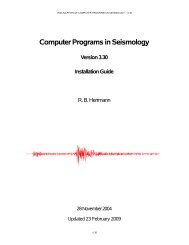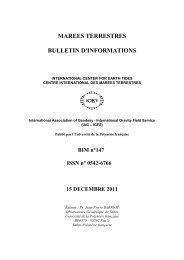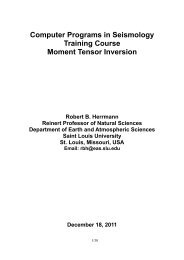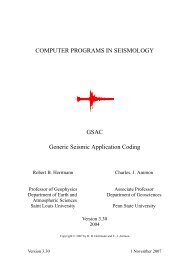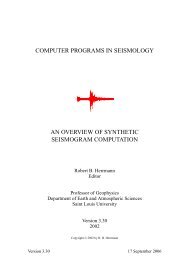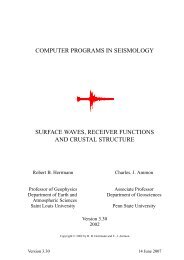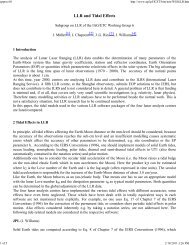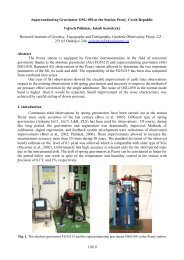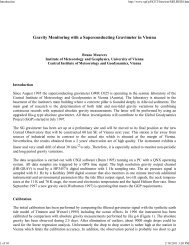3.04 Gravimetric Methods – Superconducting Gravity Meters
3.04 Gravimetric Methods – Superconducting Gravity Meters
3.04 Gravimetric Methods – Superconducting Gravity Meters
You also want an ePaper? Increase the reach of your titles
YUMPU automatically turns print PDFs into web optimized ePapers that Google loves.
74 <strong>Superconducting</strong> <strong>Gravity</strong> <strong>Meters</strong><br />
0.1 nGal. This is in effect the quantization noise of<br />
the SG þ data acquisition system, but not necessarily<br />
its precision. There is no reference gravity more<br />
accurate than the SG itself, so the precision of the<br />
SG can only be obtained by inference. In the frequency<br />
domain for studies of tides or normal modes,<br />
it is common for the SG to measure small periodic<br />
tidal signals and long-period seismic signals with a<br />
sensitivity of 1 nGal and better. Therefore, 1 nGal is<br />
generally referred to as the nominal precision, or<br />
sensitivity, of the SG.<br />
The determination of the instrumental noise of<br />
the SG is complicated by the fact that sources of the<br />
Earth noise (signals from the atmosphere, oceans, and<br />
hydrology) are generally much larger than instrumental<br />
noise for frequencies ranging from 3 10 8<br />
Hz (1 cycle per year) to 1 Hz. The SG noise is higher<br />
than Earth noise only in the small subseismic band<br />
between 1 and 20 mHz where the noise level is<br />
typically from 1 to 3 nm s 2 Hz 1/2 (0.1<strong>–</strong>0.3 mGal<br />
Hz 1/2 ) for most SG stations (Rosat et al., 2004).<br />
This is more than 2 orders of magnitude lower than<br />
the noise level of the AG as reported by Crossley et al.<br />
(2001) and Van Camp et al. (2005).<br />
It is common practice to filter and decimate data<br />
to 1 min samples to look at small temporal gravity<br />
variations; assuming white noise, the above noise<br />
level translates into a precision of 0.01<strong>–</strong>0.03 mGal.<br />
This level is consistent with common experience.<br />
For example, Meurers (2000) easily observed gravity<br />
signals of magnitude 0.1<strong>–</strong>0.3 mGal over 10<strong>–</strong>30 min<br />
intervals and Imanishi et al. (2004) identified reliable<br />
coseismic offsets of a similar magnitude.<br />
The best way to determine real-world accuracy in<br />
the temporal domain is to compare different instruments<br />
operating side by side. Two comparisons have<br />
been done <strong>–</strong> one in Miami (Richter, 1990; Klopping<br />
et al., 1995, Harnisch and Harnisch, 1995) and one in<br />
Boulder (Harnisch et al., 1998), with the result that<br />
different pairs of instruments agree to 0.1 mGal, or<br />
better. For a dual-sphere instrument, the data streams<br />
from the two spheres are largely independent,<br />
and the difference signals between two sensors of<br />
the four dual-sphere SGs are typically 1 mGal<br />
over record lengths of years. Additionally, the residual<br />
curves from the dual SG in Moxa agree within a<br />
few tenths of a mGal to the polar motion modeled<br />
using data provided by the International Earth<br />
Rotation Service (IERS). These results suggest that<br />
0.1 mGal is the time-domain accuracy of the SG for<br />
long periods.<br />
<strong>3.04</strong>.1.5 Recent Developments<br />
<strong>3.04</strong>.1.5.1 Ultralong hold time dewar<br />
Although Compact Dewars were extremely successful,<br />
the goal remained to further decrease helium consumption<br />
and annual disturbances from helium transfers. By<br />
1997, the first commercial (and somewhat) practical 4 K<br />
refrigeration systems became available. The Leybold<br />
Vacuum Products KelKool 4.2 GM coldhead produced<br />
cooling power of 50 W at 50 K at its upper stage and<br />
0.5 W at 4 K at its lower stage. It cooled well below the<br />
4.2 K liquefaction temperature of helium and produced<br />
more than 5 times the cooling power of the APD<br />
DE202. Soon afterward, GWR produced an ultralong<br />
hold time dewar (ULHD) based on the 125 l Compact<br />
Dewar design with its neck modified to accommodate<br />
the much larger 4.2 GM coldhead. This is a closedcycle<br />
system, because the helium gas condenses in the<br />
neck on the lower stage and drips back into the storage<br />
volume of the dewar (Richter and Warburton, 1998).<br />
This success pointed to the future in which SGs could<br />
operate indefinitely without transferring liquid helium<br />
or consumption of liquid helium. The first ULHD<br />
system is shown in Figure 5.<br />
Figure 5 One of the first dual-sphere instruments (CD029,<br />
now at Wettzell, Germany) with a ULHD using a Leybold<br />
KelKool 4.2 K GM coldhead. The support cranes used to<br />
insert and remove the coldhead are shown in the background.




